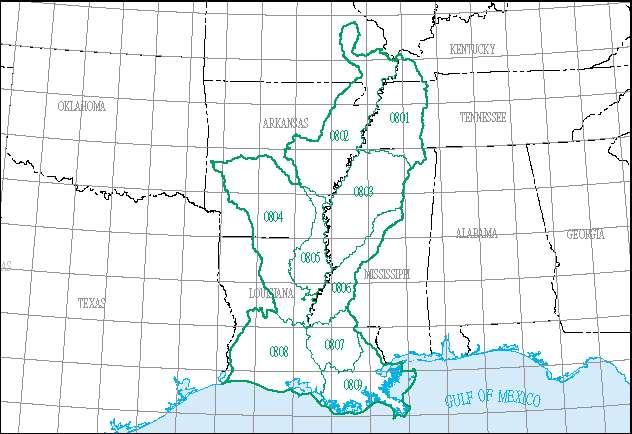Lower Mississippi water resource region
The Lower Mississippi water resource region is one of 21 major geographic areas, or regions, in the first level of classification used by the United States Geological Survey to divide and sub-divide the United States into successively smaller hydrologic units. These geographic areas contain either the drainage area of a major river, or the combined drainage areas of a series of rivers.[1][2]
The Lower Mississippi region, which is listed with a 2-digit hydrologic unit code (HUC) of 08, has an approximate size of 106,741 square miles (276,460 square kilometers), and consists of 9 subregions, which are listed with the 4-digit HUCs 0801 through 0809.
This region includes the drainage within the United States of: (a) the Mississippi River below its confluence with the Ohio River, excluding the Arkansas, Red, and White River basins above the points of highest backwater effect of the Mississippi River in those basins; and (b) coastal streams that ultimately discharge into the Gulf of Mexico from the Pearl River Basin boundary to the Sabine River and Sabine Lake drainage boundary. Includes parts of Arkansas, Kentucky, Louisiana, Mississippi, Missouri, and Tennessee.[3]

List of water resource subregions
| Subregion HUC[4] | Subregion Name[4] | Subregion Description[3] | Subregion Location[4] | Subregion Size[4] | Subregion Map |
|---|---|---|---|---|---|
| 0801 | Lower Mississippi–Hatchie subregion | The Mississippi River Basin from the confluence of the Ohio River to and including the Horn Lake Creek Basin, but excluding the drainage west of the West-Bank Levee along the Mississippi River. | Arkansas, Kentucky, Mississippi, Missouri, and Tennessee. | 11,000 sq mi (28,000 km2) |  HUC0801 |
| 0802 | Lower Mississippi–St. Francis subregion | The Mississippi River Basin from the Horn Lake Creek Basin on the east bank to and including the Arkansas and White River Basins below the points of highest backwater effect of the Mississippi River; excluding all drainage east of the East-Bank Levee below the Horn Lake Creek Basin. | Arkansas, Mississippi, and Missouri. | 16,700 sq mi (43,000 km2) |  HUC0802 |
| 0803 | Lower Mississippi–Yazoo subregion | The Mississippi River Basin from the Arkansas River Basin to and including the Yazoo River Basin; excluding all drainage west of the West-Bank Levee below the Arkansas River Basin. | Arkansas, Louisiana, Mississippi, and Tennessee. | 14,100 sq mi (37,000 km2) |  HUC0803 |
| 0804 | Lower Red–Ouachita subregion | The Red River Basin below the Bayou Rigolette Basin, excluding the Boeuf and Tensas River Basins. | Arkansas and Louisiana. | 20,500 sq mi (53,000 km2) |  HUC0804 |
| 0805 | Boeuf–Tensas subregion | The Boeuf and Tensas River Basins. | Arkansas and Louisiana. | 5,300 sq mi (14,000 km2) |  HUC0805 |
| 0806 | Lower Mississippi–Big Black subregion | The Mississippi River Basin from the Yazoo River Basin to the Lower Old River drainage boundary, but excluding all the drainage west of the West-Bank Levee along the Mississippi River. | Louisiana and Mississippi. | 7,100 sq mi (18,000 km2) |  HUC0806 |
| 0807 | Lower Mississippi–Lake Maurepas subregion | The Mississippi River Basin from the Lower Old River drainage boundary to the Bonnet Carre Floodway, and including the Lower Grand River Basin west of the West-Bank Levee. | Louisiana and Mississippi. | 5,870 sq mi (15,200 km2) |  HUC0807 |
| 0808 | Louisiana Coastal subregion | The Louisiana coastal drainage, including islands and associated waters, south of the Red River Basin boundary and west of the East-Bank Levee of the Atchafalaya Basin Floodway, to the Sabine River and Sabine Lake drainage boundary. | Louisiana | 14,000 sq mi (36,000 km2) |  HUC0808 |
| 0809 | Lower Mississippi subregion | The Mississippi River below the Bonnet Carre Floodway, and the Coastal drainage, including islands and associated waters, from the Pearl River Basin boundary and the Mississippi-Louisiana state line to the East-Bank Levee of the Atchafalaya Basin Floodway, excluding the drainage from the north into Lake Pontchartrain, east to the Tchefuncta River drainage boundary; and excludingthe Lower Grand River Basin. | Louisiana | 9,460 sq mi (24,500 km2) |  HUC0809 |
See also
- List of rivers in the United States
- Water resource region
References
- "Science in Your Watershed - Locate Your Watershed". USGS. Retrieved 2016-10-12.

- "Hydrologic Unit Maps". USGS. Retrieved 2016-10-12.

- "Boundary Descriptions and Names of Regions, Subregions, Accounting Units and Cataloging Units". USGS. Retrieved 2016-10-12.

- McManamay RA, Bevelhimer MS, Kao SC, Yaxing W, Martinez-Gonzalez M, Samu N (2013). "National Hydropower Asset Assessment Environmental Attribution". USGS-Oak Ridge National Laboratory. Retrieved 2016-10-12.
